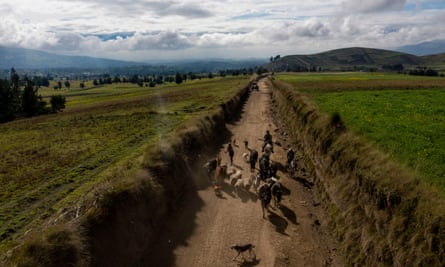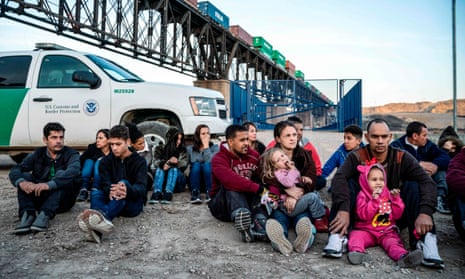Media outlets and politicians routinely refer to the “flood” of Central American migrants, the “wave” of asylum seekers, the “deluge” of children, despite the fact that unauthorized migration across the US borders is at record lows in recent years. Comparing human beings to natural disasters is both lazy and dehumanizing, but perhaps this tendency to lean on environmental language when describing migration is an unconscious acknowledgement of a deeper truth: much migration from Central America and, for that matter, around the world, is fueled by climate change.
Yes, today’s Central American migrants – most of them asylum seekers fearing for their lives – are fleeing gangs, deep economic instability (if not abject poverty), and either neglect or outright persecution at the hands of their government. But these things are all complicated and further compounded by the fact that the northern triangle of Central America – a region comprising Guatemala, El Salvador and Honduras, and the largest sources of asylum seekers crossing our border in recent years – is deeply affected by environmental degradation and the impacts of a changing global climate.

The average temperature in Central America has increased by 0.5C since 1950; it is projected to rise another 1-2 degrees before 2050. This has a dramatic impact on weather patterns, on rainfall, on soil quality, on crops’ susceptibility to disease, and thus on farmers and local economies. Meanwhile, incidences of storms, floods and droughts on are the rise in the region. In coming years, according to the US Agency for International Development, countries in the northern triangle will see decreased rainfall and prolonged drought, writ large. In Honduras, rainfall will be sparse in areas where it is needed, yet in other areas, floods will increase by 60%. In Guatemala, the arid regions will creep further and further into current agricultural areas, leaving farmers out to dry. And El Salvador is projected to lose 10-28% of its coastline before the end of the century. How will all those people survive, and where will they go?
This September, I travelled to El Salvador to report on the impacts of the US government’s family separation policy. I’d been to El Salvador many times before, but never to the Jiquilisco Bay, a stunning, shimmering and once abundant peninsula populated by mangroves and fishing communities and uncountable species of marine life. It is also one that, like many places in El Salvador, and like many places in the world, is also imperiled by climate change. Rising sea levels are destroying the mangrove forests, the marine life that relies on them, and thus the fishermen who rely on that marine life to feed themselves and eke out a meager economy.
I met a man there named Arnovis Guidos Portillo, a 26-year-old single dad. Many people in his family were fishermen, but they were able to catch fewer and fewer fish. The country’s drought and devastating rainfall meant that the area’s farming economy, too, was suffering. The land was stressed, the ocean was stressed, and so were the people. Arnovis got into a scuffle one day at a soccer game, which placed him on a hitlist with a local gang. He had been working as a day laborer here and there, but the drought meant there was less work, and it was hard to find work that didn’t require crossing into rival gang territory. If he did, he would be killed. So he took his daughter north to the United States, where border patrol agents separated them for two months, locking them up in different states and with zero contact.

Violence and environmental degradation are inextricably linked, and both lead to mass migration. An unstable planet and ecosystem lends itself to an unstable society, to divisions, to economic insecurity, to human brutality. When someone’s home becomes less and less livable, they move elsewhere. Wouldn’t each and every one of us do the same?
This week, the New Yorker’s Jonathan Blitzer published a series of pieces about the impacts of climate change in the Guatemalan highlands, where farmers are struggling to grow crops that they have been farming there for centuries. “In most of the western highlands,” Blitzer wrote, “the question is no longer whether someone will emigrate but when.” A few years ago, I reported from Guatemala’s dry corridor, several hours away from where Blitzer was reporting, where persistent drought had decimated the region’s agriculture, and particularly the coffee crop, on which roughly 90% of local farmers relied. It was a wildly different landscape from the one Blitzer described, but it faced the same problem: if you live in an agricultural zone, come from a long line of farmers and can’t reliably harvest your crops any more, what else is there to do but leave?
It’s abundantly clear that climate change is a driver of migration to the US – we have the data, we have the facts, we have the human stories. Still, the Trump administration has done nothing to intervene in this root cause. In fact, the US government has systematically denied the existence of climate change, rolled back domestic regulations that would mitigate US carbon emissions and thumbed its nose at international attempts – such as the Paris accords – to curb global warming.
Now, in his latest futile, small-minded and cruel attempt to cut migration off at the neck (something we know is not possible – an unhealthy societal dynamic must be addressed at the root, just like with a struggling tree or crop), Donald Trump announced last week that he would cut all foreign aid to the northern triangle. It’s a punitive move, and one that – just like building a wall, separating families, locking people up indefinitely, and refusing asylum seekers entry across the border – is a petty intimidation tactic that will do nothing to actually curb forced migration.
In fact, cutting aid to Central America will do quite the opposite, for as much waste and imperfections as there are in international aid, aid in Central America has been vital for creating community safety programs, job skills development and government accountability standards. It has also helped with drought mitigation and supporting climate-resilient agricultural practices. In other words, foreign aid to Central America – a place unduly hit by climate change – is supporting the kind of climate change resiliency that will keep people from having to leave in the first place.
Because people really don’t want to leave their homes for the vast uncertainty of another land, particularly when that land proves itself again and again to be hostile to migrants’ very existence. People don’t want to be raped along the route north, or die in the desert, or have their child ripped away from them by the border patrol, or be locked up indefinitely without legal counsel, without adequate medical care, with no idea what will happen to them and when. Who would risk this if things were OK back home? People like Arnovis leave because they feel like they have to.
Eventually Immigration and Customs Enforcement (Ice) officials convinced Arnovis to sign deportation papers with the promise that, if he did, he would be reunited with his daughter and returned to El Salvador. But he was shooed on to a plane back home without her. It took a tremendous amount of advocacy, but, after months locked up in the US, she, too was returned home. They are now back together, which is a good thing, but the fundamental problem hasn’t changed: he can’t find work. His society is ill. So is the planet, and the land and sea all around him.
Today, there are 64 million forced migrants around the world, more than ever before. They are fleeing war, persecution, disaster and, yes, climate change. The UN estimates that by 2050, there will be 200 million people forcibly displaced from their homes due to climate change alone.
Migration is a natural human phenomenon and, many argue, should be a fundamental right, but forced migration – being run out of home against one’s will and with threat to one’s life – is not natural at all. Today, whether we choose to see it or not, climate change is one of the largest drivers of migration, and will continue to be for years to come – unless we do something about it. If we want people to be able to stay in their homes, we have to tackle the issue of our changing global climate, and we have to do it fast.
